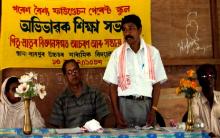North-East India, covering an area of 2,55,168 sq. km., is the home to more than 145 tribes and several non-tribal communities. A colourful region but, sans the blend of harmony. Since time immemorial, the region has been a meeting ground of many colourful races and cultures. But the tangles of history and geography, apart from divisive politics of the modern times, have robbed the people as much of the colours of their lives.
But the hopes of a prosperous region is blighted with frustration with more and more problems refusing to die down. We have tried to read between the lines in this feature.
Roots of simmering Dissention in the Region:
- The signing of the Yandaboo Treaty in 1826 A.D. led to the inclusion of undivided Assam (comprising the hills and plains of the region as a whole) in the British Empire. That brought the people of the annexed area into contact with a host of migrants from Bengal, Bihar, Rajasthan and Nepal. The floodgates of mass migration was thrown open and with the advent of railways, numerous new faces spilled all over the Brahmaputra Valley and many made inroads into the hills too. Such sudden gush of large scale migration is never feasible for assimilation. Morever, unlike the new wave of migrants (in the form of petty officials, traders etc.), the indigenous population of the region lacked experience in aggressive mercenary activities. They were naive people, primarily engaged in agricultural activities. This created a feeling of suspicion amidst the natives and the thought of being over-ridden by migrants gripped them.
- The seeds of dissention had been sown right in the days of the British Regime itself. Just as the colonial rulers devised the policy of ‘Divide and Rule’ in other parts of India on the basis of ‘Religion’, the shrewd officials cashed on the issue of ‘Ethnicity’out here. If it was Hindu-Muslim divide in Central India, in North-East India the ploy was to create a rift between the people living in the plains and those settled in the hills. Sir Andrew Clow, the last British Governor of (undivided) Assam, had secret parleys at Kohima and planned to turn it into a buffer state to have a foothold in the future. Being a shrewd British administrator, he made cautious moves to achieve his goal. At this juncture, a Naga rebel by the name of Zapho Phizo appeared in the scene who echoed secessionist intentions. Clow found an emissary in him and hinted at the establishment of a separate land for the Naga areas. Phizo was never arrested. On the other hand, a Naga queen by the name of Rani Gaidinliu could smell the rot and revolted against the British Regime. She was arrested and put in jail.
Rise of Militancy in North-East India:
- Phizo formed the militant outfit ‘Naga National Council’, the first group to resent the inclusion of Naga hills into the Indian Union. That was in 1947. They went underground in the year 1956.
- Post-independence era has seen numerous movements for ‘separate’ states in the entire North-Eastern region of India. The ethnic and religious differences provide a fertile ground for the growth of secessionist tendency in the minds of some youths. They emerge as the ‘saviours’ of their respective tribe or community and influence the vulnerable masses. After all, its easy to make war than peace.
The politically motivated youths form a militant organization in no time and start speaking on the lines of ‘separate state’, ‘autonomy’, ‘complete independence’ et al. The later part of the last century has seen the carving out of a number of hill states from the once undivided State of Assam. The States of Meghalaya, Arunachal Pradesh, Mizoram, and Nagaland are the fall out of such ethnic demarcation.
Ironically, even the allotment of separate state status to these erstwhile hill districts of Assam have not led to the ideal space of existence as envisioned by the rebels. Recent years has seen the rise of other militant groups from smaller tribes who accuse the larger tribes of exploiting their limited resources. For eg., the ‘Achik National Volunteer Council’ (ANVC) was formed in 1995 with the aim of carving out ‘Achikland’ in the Garo hills of Meghalaya. Again, the ‘Hynniewtrap National Liberation Council’(1992) aims to free the state from Garo domination. The state of Mizoram has always seen the dominance of the Mizos over the Reangs and the Hmars. The ‘Hmar People’s Convention Democracy’; HPC (D), formed in 1995 aims to establish an independent Hmar state. The ‘Bru National Liberation Front’ (BNLF), formed in 1997, came up to protect the rights and dignity of the Reangs.
Manipur, one of the most culturally developed states of India, has its own saga of insurgency. The most prominent of the insurgent groups are People’s Liberation Army (PLA), United National Liberation Front (UNLF) and many more.
Tripura is the home to militant outfits like ‘National Liberation Front of Tripura’ (NLFT), which came into force in March, 1989. Then there is the ‘All Tripura Tiger Force’ (ATTF) formed in 1990 to oust the Bengalis who have usurped the native population of the state over the decades.
In the State of Assam (divided), militancy was triggered off with the formation of the ‘United Liberation Front of Asom’ (ULFA) on April 7, 1979 in the wake of the six years long ‘Anti-Foreigners Agitation’ of 1978-83, also known as ‘Assam Agitation’ or ‘Assam Movement’. It was aimed at ousting the illegal migrants from Bangladesh who poured into the State in the aftermath of the Indo-Pak War 1971 which saw the rise of the new country called Bangladesh (i.e., East Pakistan). However, this organization has moulted into a rudderless front with no sense of conviction towards its founding principles. - The vexed problem of ‘Influx’ (illegal migration from Bangladesh) has created an identity crisis among the different sections of the Native populace of Assam. In order to protect their rights and dignity, various militant groups have come up. One of the foremost insurgent outfit in this regard is the ‘National Democratic Front of Bodoland’ (NDFB), which came into force in 1989. It was a result of dispossession of their land and the neglect of the rich Bodo culture by the non-tribal section of the people in Assam.
- The later part of 2006 saw the formation of the newly floated militant outfit by some Adivasis (tea-garden labourers) called ‘All Adivasi National Liberation Army’ (AANLA). Presently, the group demands Scheduled Tribe (ST) status for the tea-garden community in Assam.
- Incidentally, this section of the population of Assam was brought into the State by the British tea-planters in the 19th century from the Chhota Nagpur Plateau of North India. They have been working in the tea gardens of the State for about 150 years.
- Most of the youths of the region are averse to manual labour. The inclination for easy money is quite high among the people (be it young or old) out here. While the ‘leaders’ of the numerous so called ‘students’ organizations covertly aim at gaining political mileage, the ‘militant groups’ overtly engage in demanding ‘lands’ (‘land’ being the favourite word left for the militants of North-East India by the British).
Again, for many, the objective of acquiring formal education is basically aimed at landing up in a job in the corporate sector stationed in a metropolitancity, be it in India or abroad. At large, the ‘degreed’(aka ‘educated’) section lack the conviction or commitment to work for the betterment of their native places.
Resources of Insurgent Groups in the region :
One of the oft raised question is that, who provides funds for the militants to carry out such violent activities. The chief sources of income of these outfits are narcoticstrade originating from Myanmar and extortion. Also, the needle of suspicion points to certain international terror groups, certain hostile neighbouring countries like China, Bangladesh, Myanmar and religious expansionists.
It would not be just to condemn militants alone for the violence and disharmony. As long as identity politics dominate in the region, the ideology of the ‘other’ society would continue to breed insurgents of one kind or the other. No sooner one group lays down arms, another group pops up in the name of protecting their community interests.
This peculiar scenario prompted P.A. Sangma, the noted parliamentarian of the region to say that, “Insurgency has become a cottage industry in North-East India.”
Only when the people of the region shed their ethnic straitjackets and involve in common struggles for the elimination of poverty, unemployment and under- development, the region would see the light of peace and harmony. Will the prisoners of conscience awake? Over to the people of the north east.






Comments
Pages
Add new comment